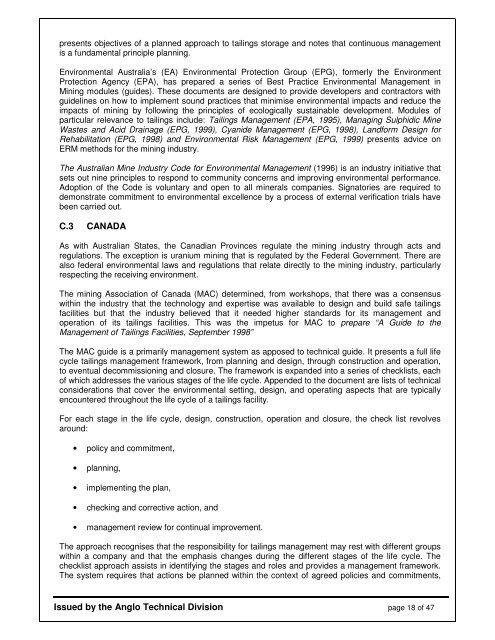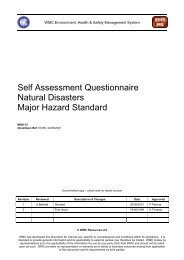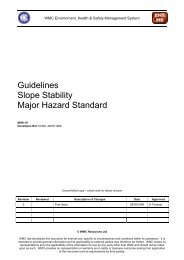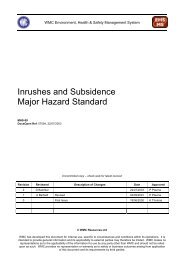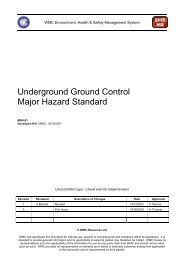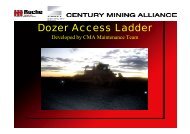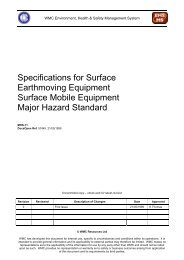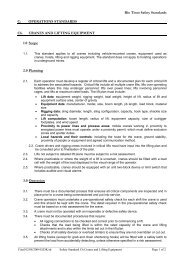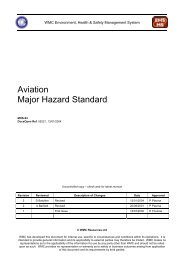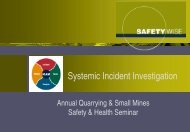SAFETY, HEALTH & ENVIRONMENT BULLETIN - MIRMgate
SAFETY, HEALTH & ENVIRONMENT BULLETIN - MIRMgate
SAFETY, HEALTH & ENVIRONMENT BULLETIN - MIRMgate
Create successful ePaper yourself
Turn your PDF publications into a flip-book with our unique Google optimized e-Paper software.
presents objectives of a planned approach to tailings storage and notes that continuous management<br />
is a fundamental principle planning.<br />
Environmental Australia’s (EA) Environmental Protection Group (EPG), formerly the Environment<br />
Protection Agency (EPA), has prepared a series of Best Practice Environmental Management in<br />
Mining modules (guides). These documents are designed to provide developers and contractors with<br />
guidelines on how to implement sound practices that minimise environmental impacts and reduce the<br />
impacts of mining by following the principles of ecologically sustainable development. Modules of<br />
particular relevance to tailings include: Tailings Management (EPA, 1995), Managing Sulphidic Mine<br />
Wastes and Acid Drainage (EPG, 1999), Cyanide Management (EPG, 1998), Landform Design for<br />
Rehabilitation (EPG, 1998) and Environmental Risk Management (EPG, 1999) presents advice on<br />
ERM methods for the mining industry.<br />
The Australian Mine Industry Code for Environmental Management (1996) is an industry initiative that<br />
sets out nine principles to respond to community concerns and improving environmental performance.<br />
Adoption of the Code is voluntary and open to all minerals companies. Signatories are required to<br />
demonstrate commitment to environmental excellence by a process of external verification trials have<br />
been carried out.<br />
C.3 CANADA<br />
As with Australian States, the Canadian Provinces regulate the mining industry through acts and<br />
regulations. The exception is uranium mining that is regulated by the Federal Government. There are<br />
also federal environmental laws and regulations that relate directly to the mining industry, particularly<br />
respecting the receiving environment.<br />
The mining Association of Canada (MAC) determined, from workshops, that there was a consensus<br />
within the industry that the technology and expertise was available to design and build safe tailings<br />
facilities but that the industry believed that it needed higher standards for its management and<br />
operation of its tailings facilities. This was the impetus for MAC to prepare “A Guide to the<br />
Management of Tailings Facilities, September 1998”<br />
The MAC guide is a primarily management system as apposed to technical guide. It presents a full life<br />
cycle tailings management framework, from planning and design, through construction and operation,<br />
to eventual decommissioning and closure. The framework is expanded into a series of checklists, each<br />
of which addresses the various stages of the life cycle. Appended to the document are lists of technical<br />
considerations that cover the environmental setting, design, and operating aspects that are typically<br />
encountered throughout the life cycle of a tailings facility.<br />
For each stage in the life cycle, design, construction, operation and closure, the check list revolves<br />
around:<br />
• policy and commitment,<br />
• planning,<br />
• implementing the plan,<br />
• checking and corrective action, and<br />
• management review for continual improvement.<br />
The approach recognises that the responsibility for tailings management may rest with different groups<br />
within a company and that the emphasis changes during the different stages of the life cycle. The<br />
checklist approach assists in identifying the stages and roles and provides a management framework.<br />
The system requires that actions be planned within the context of agreed policies and commitments,<br />
Issued by the Anglo Technical Division page 18 of 47


